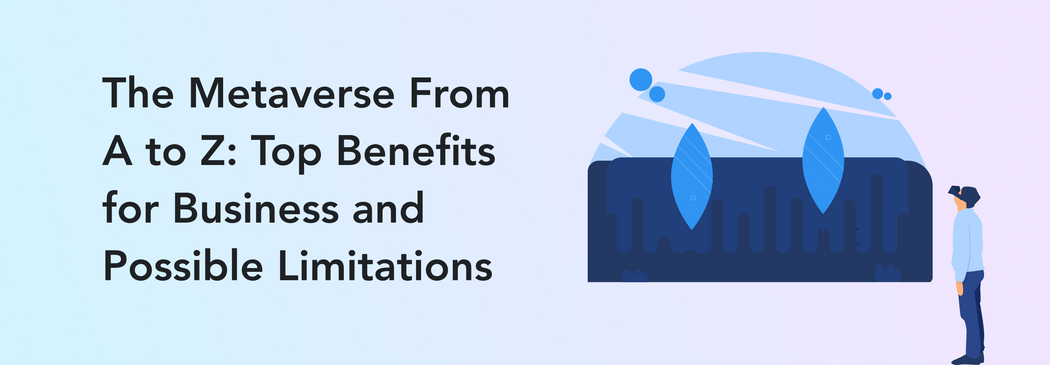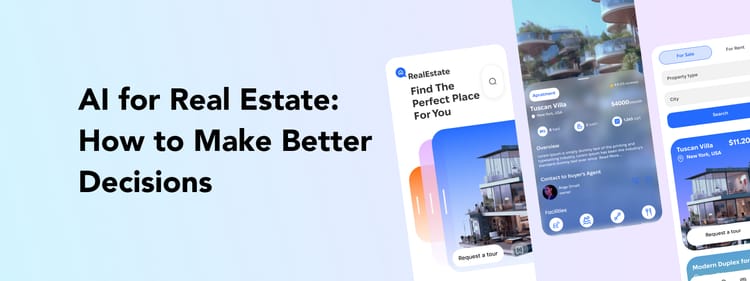A few months ago the word metaverse was known only to the big fans of science fiction. Now, the whole world is talking about it. While not necessarily understanding what exactly the metaverse is, we became absorbed with this futuristic technology and the opportunities it might bring to individuals and businesses.
While Facebook, sorry, Meta, brought the metaverse to light, they neither coined the term nor created the very phenomenon. Let’s discuss what the metaverse is, which business opportunities it presents, and why as an entrepreneur you should be aware of this new tech trend.
What is the metaverse?
Let’s start with the basics and answer the main question: What is the metaverse? Is it Facebook's invention? Is it Ready Player One's real-life adaptation? Or just a way to play video games with VR? None of those.
In fact, it is harder to define the metaverse than it seems. The video presented by Facebook demonstrates a highly futuristic, and let’s be real, so far non-existent tech solutions and experiences. Still, such an announcement already granted the metaverse a nearly $800 billion market revenue prediction. And that’s not in ten or twenty years but in 2024. Just around the corner.
So, let’s define the metaverse step-by-step. The metaverse is not original to Facebook/Meta and will not be limited solely to this platform. Meta claims that the metaverse is just like the internet itself, and this comparison gives us a good hint of how the metaverse will actually work. The internet is not just Google, the metaverse is not just Meta. It is simply a new way to get digital experiences.
Decentraland: a metaverse example
You might have observed metaverse-like structures in such platforms as Decentraland or Fortnite. With the help of VR, AR, and NFTs, users get an all-around online adventure.
Decentraland, which is one of the first-ever metaverse platforms, allows users to buy virtual items and land, attend events, like Fashion Week or live music shows, and communicate with other people. It is now becoming way more than just a game.
And that’s how the metaverse works: it is a virtual space, an alternative world, where users can potentially do the same things as offline and more. They can attend concerts they cannot visit in real life, buy digital clothes, meet with people thousands of miles away, travel in VR, and much more.
Let’s keep in mind that the metaverse is indeed a very fresh phenomenon. Its mechanism is not yet established, we cannot quite predict how such platforms will interact with each other and whether they will unite in one, the metaverse. Only in December 2021, Meta launched Horizon Worlds: a social VR experience, which can be seen as the early metaverse version.
Besides, the tech stack for joining the metaverse is still not clear. We will discuss this question in more detail later on, but for now, the point is that based on how Meta presents it, we will need a bunch of extra equipment, like VR glasses.
Decentraland demonstrates that the metaverse is more about the “parallel” digital world itself rather than the technology around it. You can simply open a web page or an app, and count yourself in — you are in the metaverse. You won’t always need VR to join virtual reality (pun intended), even though cutting-edge technologies definitely can enhance the experience.
Top benefits of the metaverse for business
Meta highlights that the metaverse (at least, the one powered by Meta itself) is not a technology that will be in common use in just a few months. The shift to the new platform might take up to ten years. Still, taking into account all the hype surrounding the metaverse and the already existing metaverse solutions, it’s safe to assume that “the future” is closer than we think.
We can expect several industries to find use of the metaverse more than others. These include:
- Gaming
- Social media
- Digital marketing
- E-commerce
- Education
- Fitness and sports
- NFTs, digital art, and virtual fashion
- Entertainment, such as TV shows, movies, etc.
So what exactly is the metaverse offering to all sorts of businesses and why should we all be looking into it right now? Let’s explore.
Find new ways to engage users
The metaverse is a whole new level of entertainment possibilities and immersive experiences, and as a business, you can use it to the fullest. If your company is among the first to introduce a metaverse experience to the customers, it will definitely give you an advantage and draw attention. Branded gaming adventures, virtual goods, and AR/VR showrooms can be the options for representing your business in the metaverse. Don't wait up and think about collaborating with interactive design companies before it becomes mainstream.
Discover opportunities for virtual events
Organizing a conference or a live show that can be attended both in person and virtually is not new. Many people cannot travel to listen to a professional conference or a lecture but it is no reason not to gain more knowledge. Alternatively to a simple Zoom or Google Meet stream, a conference in the metaverse can be not just another video in a little window and comments under it, but a full-fledged VR experience, with proper networking and participation opportunities.
A live show of a favorite artist might not be as impressive on a video stream. VR and the metaverse can definitely make this experience more immersive and give the viewers a better feeling of presence.
Galleries and museums can shift to the metaverse too. For example, Sotheby’s announced an NFT avatar exhibition project that is exclusively available on the gallery’s metaverse. 300 unique avatar items were sold out in one day.
Showcase and sell your products
Many brands are already actively using AR to let their customers try on clothes or glasses, see how new furniture would fit in their room, or get a virtual makeover with a new hairstyle or makeup. The same experiences, but better, will be possible in the metaverse.
With an opportunity to rent or buy commercial spaces, you can set up stores and showrooms, where users can check out your products in the metaverse. Even today, digital fashion is having a moment: users are actively buying virtual clothing and accessories, not to mention the separate world of gaming. Imagine what will happen with the development of the metaverse.
Introduce innovative forms of advertising
We can expect metaverse to introduce new approaches to brand storytelling and advertising in general. Storytelling is one of the most compelling approaches towards building your brand identity and awareness.
People like stories; these tell way more about the company and its values than plain slogans. Imagine how immersive and fascinating can your brand storytelling be with the VR and other technologies in the metaverse?
Storytelling will gradually transform into “storyliving”, meaning that the users won’t be passive listeners anymore but active participants or even characters who are making choices and influencing the events.
Establish better process building and team collaboration
We all have accepted the new reality of online meetings and remote teamwork. While being forced on us, these approaches still proved to be no less effective than a face-to-face office environment. The metaverse can be a way to enhance work processes even more. Meetings won’t feel like Zoom calls but rather as a group of people sitting in one room. VR workrooms have already been launched by Meta.
Benefit from easier transactions with e-wallets and cryptocurrency
The metaverse and cryptocurrency walk hand in hand. Even at this early adoption stage, we can be sure that it will be hard to enjoy the perks of the digital world without a crypto wallet. While some entrepreneurs might be overwhelmed by this idea, blockchain and cryptocurrency bring more good than bad.
The digital world requires digital money; just like you need to get special “Disney currency” in the amusement park. Cryptocurrency makes every transaction online easier both for users and businesses — no need to link your banking account with virtual worlds, payments take a few clicks, all transactions are transparent.
The latter one is especially important in the metaverse: with the metaverses of different companies interacting, you would want to have proof of all your virtual purchases.
What are the current metaverse limitations?
Even though the metaverse looks promising and highly fascinating, it remains a rather vague concept than a real technology ready to be widely used. Since the introduction to the wide public by Meta, we all have been pondering over the same questions about the metaverse:
How soon will the technology depicted in Meta’s video be possible?
While we can already take a look at the metaverses by Decentraland, Fortnite, and separate companies, when will the world shift to a full-fledged digital reality? Some of the technologies from the video are non-existent and probably won’t be in commercial use for at least a few years. VR, AR, and NFTs are what we can expect to form the metaverse for now.
What exactly will the metaverse look like?
So far, we can assume that the metaverses will exist isolated from each other: each company running its own. What Meta promises us is a unified digital world. But how unified can it be? Can the metaverse run by Facebook overlap with the one run by WeChat or these will be two separate platforms? While the metaverses’ interoperability would be a logical thing to expect from Web 3.0, we cannot yet be sure about the ways it can work out.
How engaged will the users be?
Will anyone really use the metaverse is one more question tech enthusiasts might have in mind. Of course, as with everything new, lots of people will at least peak at the metaverse out of pure curiosity. But what’s next? How do you retain the users?
We might expect more people to actively use AR-aided or simply 2D virtual services, but when it comes to VR, for example, hardware is not yet that widely accessible for the average user. Surely, such gadgets are becoming more and more popular and affordable, for instance, Google Cardboard VR set, with the prices starting from $10.
The metaverse might seem too futuristic for us to imagine using it on a daily basis now but let’s remember that blockchain and AI were unusual technologies just a while ago too.
What about the tech side and its cost?
Finally, there is the question that has been lingering on this whole blog post and which we have mentioned a few times already: What about the technology behind the metaverse? We can’t tell which new tech solutions will be available in ten years when the metaverse has to be at its peak, but as for the next few years, these will surely include:
- Virtual reality
- Augmented reality
- AR+VR: Mixed reality
- Blockchain and cryptocurrency
- Cloud
- 5G and eventually 6G
- IoT
With the help of all these technologies, even now we can access the metaverse that might exist on the edge of real and virtual realities. Faster internet connection and cloud storage will help with loading masses of data in a matter of seconds, while AR and VR will create the digital experience.
The only issue for businesses is the cost of implementing such technologies: it is a bit more pricey than getting a simple mobile app. But as a mobile app development company we can assure you that, for instance, AR is accessible for implementation even for small startups. For instance, check out our design of an AR e-commerce app — users can try on every item before buying it.
Summing up: is the metaverse present or future of tech?
Is the metaverse a technology that is right around the corner or something that won’t come in active use for at least several years? Probably both, however paradoxical that might sound. While early prototypes of the metaverse are already here to test, its more complex variants won’t be available that soon, especially if you are expecting something like in Meta’s video.
Ready to get one step closer to the metaverse and implement AR, VR, or other fun technologies in your mobile app? Let us help you — we are open to new projects.





